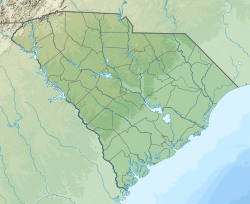Temple Sinai (Sumter, South Carolina)
| Temple Sinai | |
|---|---|
 Temple Sinai in 2014 | |
| Religion | |
| Affiliation | Reform Judaism |
| Ecclesiastical or organizational status | Synagogue |
| Leadership | Lay led |
| Status | Active |
| Location | |
| Location | 11-13 Church Street, Sumter, South Carolina 29150 |
| Country | United States |
Location in South Carolina | |
| Geographic coordinates | 33°55′17.7″N 80°20′48.4″W / 33.921583°N 80.346778°W |
| Architecture | |
| Type | Synagogue |
| Style | Moorish Revival |
| Date established | 1895 (as a congregation) |
| Completed | 1912 |
| Materials | Brick |
| Website | |
| templesinaisumter | |
Temple Sinai | |
| Area | less than one acre |
| NRHP reference No. | 98001645[1] |
| Added to NRHP | January 21, 1999 |
Temple Sinai, also known as Congregation Sinai, whose official name is the Sumter Society of Israelites, is an historic Reform Jewish congregation and synagogue, located at 11-13 Church Street, on the corner of West Hampton Avenue, in Sumter, South Carolina, in the United States.[2][3]
Built in 1912 of brick in the Moorish Revival style, Temple Sinai was added to the National Register of Historic Places on January 21, 1999. It also houses the Temple Sinai Jewish History Center that opened in June 2018.[2]
History
[edit]The first Jewish settlers in Sumter were Sephardi who came from Charleston in 1815. Congregation Sinai was formed in April 1895, by the merger of the Hebrew Cemetery Society and the Sumter Hebrew Benevolent Society. Visiting rabbis from Charleston and Augusta, Georgia, served the congregation until 1904 when Rabbi Jacob Klein settled in Sumter. The sanctuary of the present temple was built in 1912 facing Church Street to replace an earlier wooden synagogue on the site.[4]
The Barnett Memorial Addition, a two-story brick Moorish Revival auditorium/banquest hall and classroom/office building facing West Hampton Avenue, was built in 1932, behind the sanctuary, which it complements. In 1956, the one story brick Hyman Brody Building was attached to the rear of the Barnett Memorial Addition to provide a kitchen and more classrooms, offices and restrooms. Although simpler than the other two buildings, it still has some Moorish features.[2]
Temple Sinai's archives have been donated to the Jewish Heritage Collection at the College of Charleston.[5]
Stained glass windows
[edit]Temple Sinai is noted for the eleven drapery glass stained glass windows on its side and entrance walls, which depict scenes from the Tanakh. With the exception of one round window high over the entrance portico, the windows are uniformly 5 by 20 feet (1.5 by 6.1 m) and in their shape mimic the castellated domed Moorish towers that flank the entrance.[4][6]
Current status
[edit]Temple Sinai entered into an agreement with Coastal Community Foundation, Kahal Kadosh Beth Elohim Synagogue, and the Charleston Jewish Federation to maintain its cemetery and Temple and to address concerns regarding its long-term viability. Additionally, in 2015, Temple Sinai entered a partnership with the Sumter County Museum to create a permanent exhibit about Jewish history in South Carolina and in Sumter. The museum also includes a section devoted to the Holocaust and Sumter's ties to the Holocaust,[7] and opened to the public on June 2, 2018.[8]
See also
[edit]References
[edit]- ^ "National Register Information System". National Register of Historic Places. National Park Service. July 9, 2010.
- ^ a b c Richardson, Katherine H. (June 3, 2003). "Temple Sinai" (PDF). National Register of Historic Places - Nomination and Inventory. Retrieved September 8, 2012.
- ^ "Temple Sinai, Sumter County (11 Church St., Sumter)". National Register Properties in South Carolina. South Carolina Department of Archives and History. Retrieved September 8, 2012.
- ^ a b "History of Temple Sinai". Jewish Historical Society of South Carolina. Retrieved February 20, 2018.
- ^ "Jewish Heritage Collection". College of Charleston Addlestone library. Retrieved February 20, 2018.
- ^ "Jewish Heritage Days, Sumter, SC". Jewish Historical Society of South Carolina. March 2006. Archived from the original on July 9, 2008.
- ^ "Temple Sinai Jewish History Center". Sumter County Museum. n.d.
- ^ Levere, Jane L. (December 1, 2010). "Jewish Congregations Turn to Living Wills". The New York Times. ISSN 0362-4331. Retrieved February 20, 2018.
External links
[edit]- Official website
- "Directory of South Carolina Synagogues". Jewish Historical Society of South Carolina. n.d.
- "Temple Sinai Cemetery Listings". Jewish Historical Society of South Carolina. n.d.
- Schmidt, Kenneth (2005). "Transcription of Sumter Jewish Cemetery". Ancestry.com.
- "History of Temple Sinai". Goldring/Woldenberg Institute of Southern Jewish Life. Retrieved November 30, 2010.
- 1895 establishments in South Carolina
- 20th-century synagogues in the United States
- Buildings and structures in Sumter County, South Carolina
- Jewish organizations established in 1895
- Moorish Revival architecture in South Carolina
- Moorish Revival synagogues
- National Register of Historic Places in Sumter County, South Carolina
- Reform synagogues in South Carolina
- Sephardi Jewish culture in South Carolina
- Sephardi Reform Judaism
- Synagogues completed in 1912
- Synagogues on the National Register of Historic Places in South Carolina



